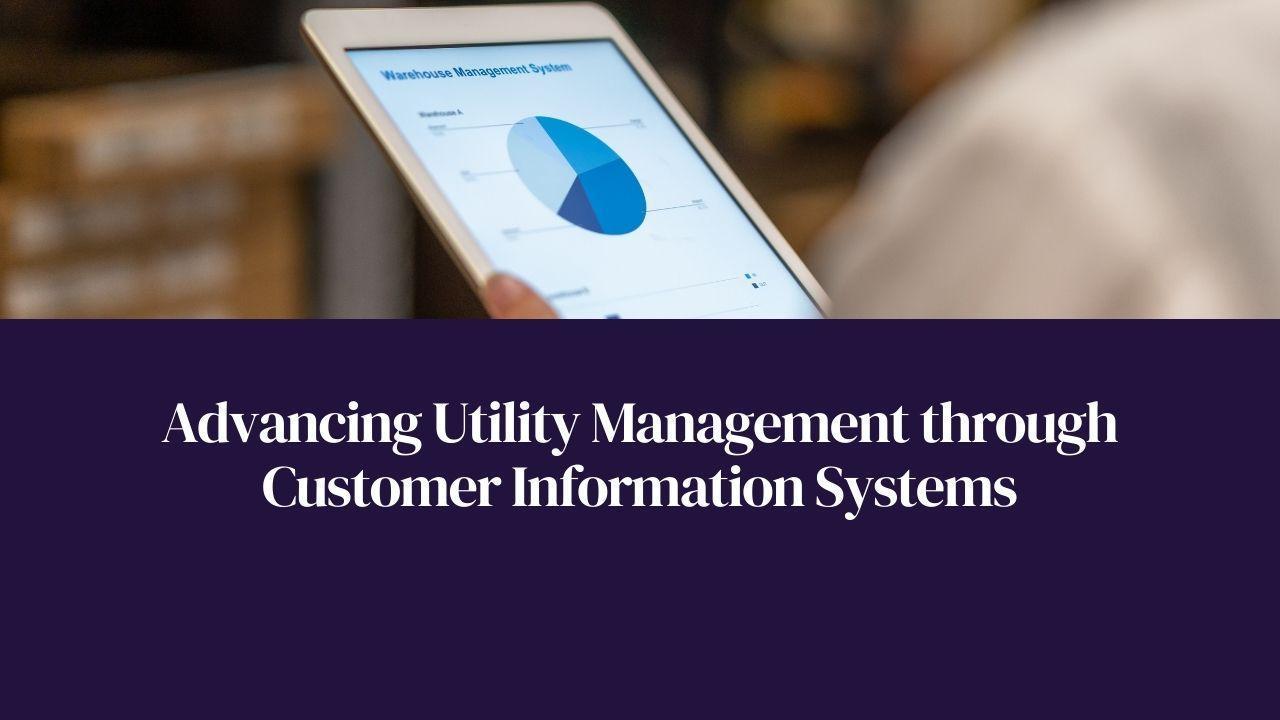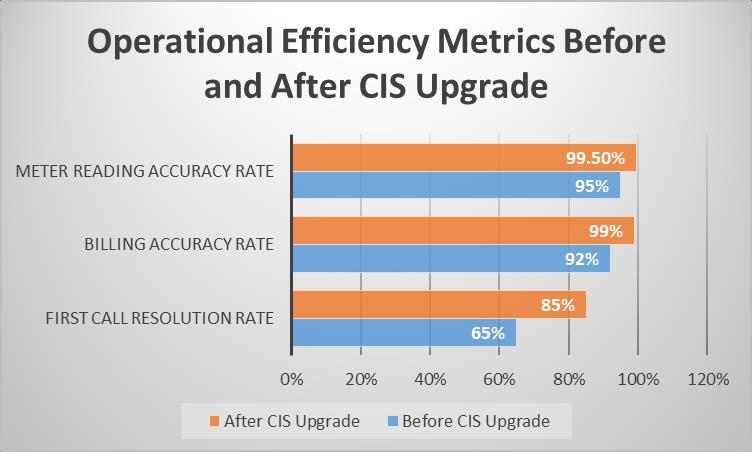
International Research Journal of Engineering and Technology (IRJET) e-ISSN:2395-0056
Volume: 11 Issue: 07 | July 2024 www.irjet.net p-ISSN:2395-0072


International Research Journal of Engineering and Technology (IRJET) e-ISSN:2395-0056
Volume: 11 Issue: 07 | July 2024 www.irjet.net p-ISSN:2395-0072
Rajesh Kolli Mastech Digital, Inc., USA

Abstract
rapid evolution of the energy sector has necessitated the modernization of Customer Information Systems (CIS) for utility companies. This article explores the significance of CIS upgrades in transforming utility operations and delivering enhanced customer service. By examining the common challenges associated with legacy systems, such as scalability issues, integration difficulties, and maintenance challenges, the article highlights the compelling need for utilities to embraceadvancedCISsolutions.ThekeycomponentsofasuccessfulCISupgradearediscussedindetail,emphasizingthe imp
The ortanceofenhanceduserinterfaces,advanceddata handlingcapabilities,andseamlessintegrationwithothercritical utility systems. The article also provides a comprehensive, step-by-step guide to the CIS upgrade process, covering essential phases such as assessment, planning, implementation, and training and support. To illustrate the tangible benefitsofa well-executedCISupgrade,thearticlepresentsareal-worldcasestudyoftheCatapultProjectattheKansas Board of Public Utilities, showcasing the significant improvements achieved in operational efficiency, customer service, billing acc
uracy, and data-driven decision-making. Ultimately, this article serves as a valuable resource for utility companies considering a CIS upgrade, offering insights into best practices, potential outcomes, and the strategic importanceofmodernizingtheirsystemstoremaincompetitiveinanincreasinglydynamicenergylandscape.
Keywords: Customer Information Systems (CIS), Utility operations, CIS upgrade, Systems integration, Operational efficiency
1. Introduction
In the rapidly evolving landscape of utility operations, the role of Customer Information Systems (CIS) has become increasinglycritical.CISservesasthebackbone ofutilitycompanies,enabling them toeffectivelymanagecustomer data, billing, and interactions [1]. As the energy sector faces new challenges, such as the integration of renewable energy sources and the adoption of smart grid technologies, the need for robust and efficient CIS has never been more pressing [2].

International Research Journal of Engineering and Technology (IRJET) e-ISSN:2395-0056
Volume: 11 Issue: 07 | July 2024 www.irjet.net p-ISSN:2395-0072
The importance of CIS in managing customer interactions and billing cannot be overstated. A well-designed CIS allows utilitiestostreamlinetheirprocesses,reduceerrors,andimprovecustomersatisfaction.However,manyutilitiesstillrely onlegacysystemsthatarenolongercapableofmeetingthedemandsofmodernoperations.Theseoutdatedsystemsoften sufferfromscalabilityissues,integrationdifficulties,pooruserexperience,andhighmaintenancecosts[1].
UpgradingaCISisnotmerelyanoptionbut a necessityforutilitiesseekingtoremaincompetitiveandmeettheevolving needs of their customers. A modern CIS offers a range of benefits, including enhanced user interfaces, improved data handlingcapabilities,superiorcustomerservice,andfuture-proofing[2].ByinvestinginaCISupgrade,utilitiescanunlock thefullpotentialoftheiroperationsandpositionthemselvesforlong-termsuccess.
This article aims to provide a comprehensive guide to CIS upgrades for utilities. We will explore the common challenges associated with legacy systems, the key components of a successful upgrade, and the steps involved in the upgrade process.Additionally,wewillpresentareal-worldexampleofasuccessfulCISupgradethroughtheCatapultProjectatthe Kansas Board of Public Utilities. By the end of this article, readers will have a clear understanding of the benefits and considerationsinvolvedinupgradingtheirCISandwillbeequippedwiththeknowledgenecessarytoembarkontheirown upgradejourney.
Legacy Customer Information Systems (CIS) often struggle to keep pace with the evolving needs of modern utility operations. These outdated systems present a range of challenges that hinder efficiency, productivity, and customer satisfaction. In this section, we will delve into the most common issues associated with legacy CIS, including scalability limitations,integrationdifficulties,pooruserexperience,andmaintenancechallenges.
2.1.
One of the primary drawbacks of legacy CIS is their inability to scale effectively as utility companies grow and their customer base expands. These systems were often designed with a specific capacity in mind and lack the flexibility to accommodate increasing data volumes and transaction rates [3]. As a result, utilities may experience slow processing times,systemcrashes,anddatainconsistencieswhentheirCISispushedbeyonditsoriginallimits.
Legacy CIS often operate in isolation, making it difficult to integrate them with other essential utility systems, such as Meter Data Management (MDM), Geographic Information Systems (GIS), and Customer Relationship Management (CRM) platforms. This lack of integration can lead to data silos, manual data entry, and inefficient workflows [4]. Without seamlesscommunicationbetweensystems,utilitiesstruggletogainaholisticviewoftheiroperationsandmakeinformed decisionsbasedoncomprehensivedataanalysis.
2.3.
Userexperienceisacrucialfactorintheeffectivenessofanysoftwaresystem,andlegacyCISoftenfallshortinthisregard. Thesesystemstypicallyfeatureoutdateduserinterfaces,complexnavigation,andlimitedfunctionality,makingitdifficult forutilitystafftoperformtheirdailytasksefficiently[3].Pooruserexperiencecanleadtoincreasedtrainingtime,higher errorrates,andloweremployeesatisfaction,ultimatelyimpactingthequalityofserviceprovidedtocustomers.
2.4.
Maintaining legacy CIS can be a significant burden for utility companies. As these systems age, they become increasingly difficultandexpensivetoupdateandsupport.LegacyCISoftenrelyonoutdatedtechnologiesandprogramminglanguages, making it challenging to find skilled personnel capable of maintaining and troubleshooting the system [4]. Additionally, legacy CIS may lack proper documentation, further complicating maintenance efforts and increasing the risk of system failuresanddataloss.
The challenges posed by legacy CIS can have far-reaching consequences for utility operations. Scalability issues limit growthpotential,integrationdifficultieshinderdata-drivendecision-making,pooruserexperiencereducesefficiency,and maintenancechallengesdrainresources.RecognizingtheselimitationsisthefirststepinunderstandingtheneedforaCIS upgrade. By addressing these challenges head-on, utilities can lay the foundation for a more efficient, reliable, and customer-centricfuture.

Volume: 11 Issue: 07 | July 2024 www.irjet.net p-ISSN:2395-0072
Upgrading a Customer Information System (CIS) offers a multitude of benefits that can transform utility operations, enhance customer satisfaction, and drive long-term success. By modernizing their CIS, utilities can take advantage of enhanced user interfaces, improved data handling capabilities, superior customer service, and future-proofing. In this section,wewillexploreeachofthesebenefitsindetail.
A modern CIS provides a vastly improved user interface compared to legacy systems. With intuitive navigation, streamlinedworkflows,andcustomizabledashboards,awell-designeduserinterfaceempowersutilitystafftoworkmore efficientlyandeffectively[5].Enhanceddatavisualizationtoolsallowuserstoquicklygraspcomplexinformation,identify trends,andmakeinformeddecisions.Byreducingthelearningcurveandminimizingthepotentialforerrors,anenhanced userinterfacecansignificantlyboostproductivityandjobsatisfactionamongutilityemployees.
Upgrading to a modern CIS enables utilities to harness the power of improved data handling capabilities. Advanced CIS platforms are designed to process and manage large volumes of data with ease, ensuring fast and reliable performance even as the utility's customer base grows [6]. Robust data validation and cleansing mechanisms help maintain data integrity, reducing the risk of errors and inconsistencies. With real-time data processing and advanced analytics tools, utilitiescangainvaluableinsightsintocustomerbehavior,consumptionpatterns,andoperationalinefficiencies,enabling data-drivendecision-makingandstrategicplanning.
A CIS upgrade can revolutionize the way utilities interact with their customers, leading to superior customer service. ModernCISplatformsofferarangeoffeaturesdesignedtoenhancethecustomerexperience,suchasself-serviceportals, multi-channel communication options, and personalized billing [5]. With access to comprehensive customer data and intelligent workflows, utility staff can quickly resolve inquiries, address concerns, and provide tailored solutions. By empowering customers with tools to manage their accounts, monitor usage, and make informed decisions about their energyconsumption,utilitiescanfostergreatercustomerengagementandloyalty.










3.4.
InvestinginaCISupgradeisastrategicmovethatfuture-proofsutilityoperations.Astechnologyadvancesandcustomer expectations evolve, a modernCIS provides the flexibilityandscalability needed to adaptand thrive [6]. Witha modular architecture and open integration capabilities, a future-proof CIS can easily accommodate new features, third-party

International Research Journal of Engineering and Technology (IRJET) e-ISSN:2395-0056
applications,andemergingtechnologiessuchassmartmeters,renewableenergyintegration,andelectricvehiclecharging infrastructure. By staying ahead of the curve and embracing innovation, utilities can position themselves for long-term successinanincreasinglydynamicandcompetitivemarket.
The benefits of upgrading a CIS are far-reaching and transformative. From enhanced user interfaces that boost productivity to improved data handling that enables data-driven decision-making, a modern CIS empowers utilities to optimize their operations and deliver exceptional customer service. By future-proofing their systems, utilities can stay agile and responsive in the face of evolving challenges and opportunities. Embracing a CIS upgrade is not just a technologicalinvestment;itisastrategicchoicethatcanunlocknewlevelsofefficiency,customersatisfaction,andgrowth forutilitycompanies.
Benefit
Enhanced User Interface
Advanced Data Handling
SeamlessIntegration
Description
Intuitive navigation, simplified workflows, anddatavisualization
Efficient processing and management of largedatavolumes
Real-time data exchange and unified view ofoperations
Improved Customer Service Self-service portals, multi-channel communication,andpersonalizedbilling
Scalability and Future-Proofing
Modulararchitectureandopenintegration capabilities
Impact
Increased productivity and user satisfaction
Improved decision-making and operationalefficiency
Streamlined processes and enhanced collaboration
Higher customer satisfaction and reducedsupportcosts
Adaptability to changing market conditionsandregulatoryrequirements
Table1:KeyBenefitsofaCISUpgrade[5,6]
A successful CIS upgrade involves several key components that work together to transform utility operations. These componentsincludean enhanceduser interface,advanceddata handlingcapabilities,and robustintegration features.By focusingonthesecriticalareas,utilitiescanensurethattheirCISupgradedeliversmaximumvalueandmeetstheevolving needsoftheirorganizationandcustomers.
4.1.
A modern CIS should offer a streamlined and intuitive user interface that simplifies navigation and reduces the learning curveforutilitystaff.Byorganizingfeaturesandfunctionsintological,easy-to-accessmenusandprovidingclear,concise labeling, a well-designed user interface enables users to quickly find the tools and information they need [7]. Simplified navigation not only saves time but also reduces the risk of errors and frustration, leading to increased productivity and usersatisfaction.
Effective data visualization is a crucial component of an enhanced user interface. By presenting complex data in a clear, visuallyappealingmanner,amodernCISempowersutilitystafftoquicklygraspinsightsandmakeinformeddecisions[8]. Interactivedashboards,customizablereports,andreal-timedatadisplaysallowuserstoexploreandanalyzeinformation frommultipleperspectives,uncoveringtrends,patterns,andanomaliesthatmightotherwisegounnoticed.Improveddata visualizationhelpsutilitiesleveragethefullpotentialoftheirdata,drivingoperationalefficiencyandstrategicplanning.
As utilities collect ever-increasing amounts of data from smart meters, IoT devices, and other sources, advanced data handling capabilities become essential. A modern CIS must be capable of efficiently processing and managing large data volumes without compromising performance or reliability [7]. By leveraging cutting-edge technologies such as big data platforms,distributedcomputing,andcloud-basedstorage,a CISupgradecan ensurethatutilitystaffhave fast,seamless accesstothedatatheyneed,regardlessofvolumeorcomplexity.
Volume: 11 Issue: 07 | July 2024 www.irjet.net p-ISSN:2395-0072 © 2024, IRJET | Impact Factor value: 8.226 | ISO 9001:2008 Certified Journal | Page1205

International Research Journal of Engineering and Technology (IRJET) e-ISSN:2395-0056
Volume: 11 Issue: 07 | July 2024 www.irjet.net p-ISSN:2395-0072
Data quality is a critical concern for utilities, as inaccurate or incomplete data can lead to faulty decisions, regulatory compliance issues, and customer dissatisfaction. A CIS upgrade should include robust data cleansing and validation mechanisms thatautomaticallydetectandcorrect errors,inconsistencies,andduplicatesin the data [8].Automateddata updating ensures that the CIS always reflects the most current and accurate information, reducing the need for manual interventionandminimizingtheriskofdata-relatedissues.
A modern CIS should not operate in isolation but rather integrate seamlessly with other critical utility systems, such as Meter Data Management (MDM), Geographic Information Systems (GIS), and Customer Relationship Management (CRM) platforms.Byenablingsmooth,real-timedataexchangebetweenthesesystems,aCISupgradebreaksdowndatasilosand provides a unified view of utility operations [7]. Seamless integration allows utility staff to accessand analyzedata from multiplesources,makingiteasiertoidentifyopportunitiesforimprovementandrespondquicklytochangingconditions.
Robust integration capabilities enable a holistic view of utility operations, empowering decision-makers with comprehensive, actionable insights. By combining data from various systems and applying advanced analytics tools, a modernCIScanhelputilitiesuncoverhiddenpatterns,predictfuturetrends,andoptimizeperformanceacross theentire organization[8].Fromimprovingenergyefficiencyandreducingcoststoenhancingcustomerserviceandmanagingassets moreeffectively,aCISupgradewithstrongintegrationfeaturescandrivetransformativebenefitsforutilities.
By focusing on these key components - an enhanced user interface, advanced data handling capabilities, and robust integrationfeatures-utilitiescanensurethattheirCISupgradedeliversmaximumvalueandpositionsthemforlong-term successinanincreasinglydata-drivenandcustomer-centriclandscape.
Upgrading a Customer Information System (CIS) is a complex undertaking that requires careful planning, execution, and management.Toensureasuccessfulupgrade,utilitiesmustfollowastructuredapproachthataddressesallaspectsofthe process, from initial assessment to post-implementation support. This section outlines the key steps involved in a CIS upgrade,includingassessment,planning,implementation,andtrainingandsupport.
The first step in the upgrade process is to conduct a thorough performance analysis of the current CIS. This involves evaluating the system's responsiveness, reliability, and scalability, as well as identifying any bottlenecks or inefficiencies thatmaybehinderingperformance[9].Byunderstandingthelimitationsoftheexistingsystem,utilitiescanbetterdefine therequirementsforthenewCISandensurethatitmeetstheirneeds.
Gathering feedback from end-users is crucial in assessing the current system's limitations and identifying areas for improvement. This can be done through surveys, interviews, or focus groups, allowing users to share their experiences, frustrations, and suggestions for enhancing the CIS [10]. User feedback provides valuable insights into the day-to-day challengesfacedbyutilitystaffandhelpsensurethatthenewsystemaddressestheseissueseffectively
A technical evaluation of the current CIS involves assessing its architecture, hardware, software, and integration capabilities.Thisstephelpsidentifyanyoutdated orunsupportedcomponentsthatmayneedtobereplacedorupgraded aspartofthetransitiontoanewsystem[9].ItalsohelpsdeterminethefeasibilityofintegratingthenewCISwithexisting utilitysystemsandensuresthatthenecessarytechnicalresourcesareinplacetosupporttheupgrade.
Evaluating the current CIS's compliance with industry regulations and security standards is essential in determining the scopeoftheupgrade.Thisinvolvesassessingthesystem'sabilitytoprotectsensitivecustomerdata,maintaindataprivacy, and comply with relevant laws and regulations [10]. By identifying any compliance or security gaps, utilities can ensure thatthenewCISmeetsallnecessaryrequirementsandminimizestheriskofdatabreachesorlegalissues.
OncethelimitationsofthecurrentCIShavebeenassessed,thenextstepistodefineclearobjectivesfortheupgrade.This involves identifying the specific goals and outcomes that the utility hopes to achieve with the new system, such as improving customer service, increasing operational efficiency, or enabling new business processes [9]. By setting well-

International Research Journal of Engineering and Technology (IRJET) e-ISSN:2395-0056
Volume: 11 Issue: 07 | July 2024 www.irjet.net p-ISSN:2395-0072
defined objectives, utilities can ensure that the upgrade aligns with their overall strategic priorities and delivers measurablebenefits.
With objectivesinplace,utilitiescan begin evaluating andselectingthetechnologiesthatwill formthe foundationof the new CIS. This involves researching and comparing various vendor offerings, assessing their features, scalability, and integrationcapabilities,anddeterminingwhichsolutionsbestfittheutility'sneedsandbudget[10].Technologyselection should also take into account the utility's long-term goals and ensure that the chosen platform can accommodate future growthandevolvingrequirements.
Choosing the right vendoriscritical tothesuccessof a CISupgrade. Utilitiesshould evaluate potential vendors based on their experience, expertise, and track record in implementing CIS solutions [9]. This involves assessing their financial stability,customerreferences,andabilitytoprovideongoingsupportandmaintenance.Utilitiesshouldalsoconsiderthe vendor's willingness to collaborate and adapt to their specific needs and requirements. Developing a comprehensive budget and timeline is essential in planning a CIS upgrade. This involves estimating the costs associated with hardware, software, implementation, training, and ongoing maintenance, as well as allocating the necessary financial and human resourcestosupporttheproject[10].Thetimelineshouldberealisticandtakeintoaccountthecomplexityoftheupgrade, theavailabilityofresources,andanypotentialrisksordelaysthatmayarise.
Effective project management is crucial to the success of a CIS upgrade. This involves establishing a clear governance structure,definingrolesandresponsibilities,andensuringthatallstakeholdersare aligned andinformedthroughoutthe process[9].Projectmanagersshouldregularlymonitorprogress,identifyandmitigaterisks,andensurethattheupgrade staysontrackandwithinbudget.
MigratingdatafromtheoldCIStothenewsystemisacriticalstepintheimplementationprocess.Thisinvolvesextracting, transforming,andloadingdatafromvarioussources,ensuringdataintegrityandaccuracy,andminimizingtheriskofdata loss or corruption [10]. Utilities should develop a comprehensive data migration plan that addresses data mapping, validation,andtesting,andensuresthatallnecessarydataissuccessfullytransferredtothenewsystem.
Integrating the new CIS with existing utility systems, such as billing, customer service, and outage management, is essential for ensuring seamless operations and data flow [9]. This involves developing and testing interfaces, APIs, and data exchange mechanisms, and ensuring that all systems can communicate and share data effectively. Utilities should workcloselywithvendorsandinternalITteamstoensurethatintegrationisproperlyplannedandexecuted.
Rigorous testing and quality assurance are critical in ensuring that the new CIS meets all requirements and performs as expected. This involves conducting unit testing, integration testing, system testing, and user acceptance testing, and identifying and resolving any defects or issues that arise [10]. Utilities should establish clear testing protocols and acceptancecriteria, and ensurethatall stakeholdersare involved in the testingprocess.To minimizedisruption andrisk, utilities may choose to implement the new CIS in phases, gradually transitioning users and processes to the new system over time [9]. This approach allows for more controlled and manageable change, and provides opportunities for continuousimprovementandrefinementbasedonuserfeedbackandlessonslearned.
ProvidingcomprehensivetrainingisessentialinensuringthatusersarecomfortableandproficientwiththenewCIS.This involvesdevelopingtailoredtrainingprogramsfordifferentusergroups,suchascustomerservicerepresentatives,billing specialists,andfieldtechnicians,anddelivering training througha varietyofmethods,suchasin-personsessions,online courses, and hands-on simulations [10]. Training should cover not only the technical aspects of the system but also the businessprocessesandworkflowsthatuserswillneedtofollow.
Providing ongoing support is critical in ensuring the success of a CIS upgrade. This involves establishing a dedicated support team, creating user guides and documentation, and providing multiple channels for users to access help and assistance,suchasphone,email,andchat[9].Supportresourcesshouldbeeasilyaccessibleandresponsive,andshouldbe abletohandlearangeofissuesandquestions,fromsimpletroubleshootingtomorecomplextechnicalproblems.
Establishing a feedback mechanism is important in ensuring that the new CIS meets the needs of users and continues to improveovertime.Thisinvolvescreatingchannelsfor userstoprovidefeedback andsuggestions,suchassurveys,focus groups, and user forums, and regularly analyzing and acting on this feedback to identify areas for improvement [10].

International Research Journal of Engineering and Technology (IRJET) e-ISSN:2395-0056
Volume: 11 Issue: 07 | July 2024 www.irjet.net p-ISSN:2395-0072
Utilities should also establish metrics and key performance indicators (KPIs) to track the success of the upgrade and measureitsimpactonusersatisfactionandoperationalefficiency.
Providing ongoing education and training is essential in ensuring that users stay up to date with new features, enhancements,andbestpracticesrelatedtotheCIS.Thisinvolvesdevelopingacontinuouslearningprogramthatincludes regulartrainingsessions,workshops,ande-learningmodules,andencouraginguserstotakeadvantageoftheseresources [9]. Utilities should also foster a culture of knowledge sharing and collaboration, where users can learn from each other andsharetheirexperiencesandinsights.
By following these steps and best practices, utilities can ensure a successful and smooth CIS upgrade that delivers significantbenefitsandvaluetotheorganizationanditscustomers.
TheCatapultProject,undertakenbytheKansasBoardofPublicUtilities(BPU),servesasacompellingreal-worldexample of a successful CIS upgrade. This section provides an overview of the project and highlights the key outcomes and improvementsachieved,demonstratingthetransformativeimpactofawell-executedCISupgrade.
The KansasBPU,recognizingthelimitationsofitslegacyCISandthe need tomodernizeitsoperations,embarkedonthe Catapult Project. The project aimed to replace the outdated system with a state-of-the-art CIS that could support the utility'scurrentandfutureneeds,enhancecustomerservice,andimproveoverallefficiency[11].
The legacy CIS at Kansas BPU was struggling to keep pace with the growing demands of the utility's operations. The systemwasslow,inflexible,andlackedthenecessaryfeaturesandfunctionalitytosupportmoderncustomerexpectations and regulatory requirements. Additionally, the system was becoming increasingly expensive to maintain and support, divertingvaluableresourcesfromothercriticalinitiatives.
Feature Legacy CIS
Architecture
Monolithicandrigid
DataProcessing Slowandlimited
Integration
Difficultandoftenmanual
UserInterface Complexandoutdated
CustomerService
Reactive and limited self-service options
Scalability Limitedandexpensivetoscale
Upgraded CIS
Modularandflexible
Fastandcapableofhandlinglargevolumes
Seamlessandautomated
Intuitiveandmodern
Proactive and extensive self-service capabilities
Easilyscalableandcost-effective
Table2:ComparisonofLegacyCISandUpgradedCIS[12,13]
Toaddressthesechallenges,theKansasBPUpartneredwithaleadingCISvendorandinitiatedacomprehensiveupgrade project.Theprojectinvolvedathoroughassessmentoftheutility'srequirements,theselectionofarobustandscalableCIS platform,andaphasedimplementationapproachtominimizedisruptionandensureasmoothtransition.
ThesuccessfulimplementationoftheCatapultProjectyieldedsignificantimprovementsandbenefitsfortheKansasBPU, its employees, and its customers. The following subsections highlight the key outcomes and improvements achieved acrossvariousareasoftheutility'soperations.
OneofthemostnotableoutcomesoftheCISupgradewasthesignificantimprovementinoperationalefficiency.Thenew system streamlined and automated many manual processes, reducing the time and effort required to complete routine tasks.Thisallowedemployeestofocusonmorevalue-addedactivities,suchascustomerserviceandstrategicinitiatives.

International Research Journal of Engineering and Technology (IRJET) e-ISSN:2395-0056
Volume: 11 Issue: 07 | July 2024 www.irjet.net p-ISSN:2395-0072

ThenewCISalsoprovided acentralizedplatformformanagingcustomerdata,eliminatingdatasilosandimprovingdata accuracyandconsistency.This,inturn,reducederrorsandinconsistencies,leadingtofasterandmoreaccuratedecisionmaking.
TheCatapultProjecthada profoundimpactonthequalityofcustomerserviceprovidedbytheKansasBPU.ThenewCIS included a range of features and tools designed to enhance the customer experience, such as self-service portals, multichannelcommunicationoptions,andpersonalizedbilling.
With the new system, customer service representatives had access to comprehensive customer data and could quickly resolve inquiries and issues. The self-service portal allowed customers to easily manage their accounts, view usage data, andmakepaymentsonline,reducingtheneedforphonecallsandin-personvisits.
TheCISupgradesignificantlyimprovedtheaccuracyandtimelinessofbillingprocesses.Thenewsystemautomatedmany billingtasks,suchasmeterreading,billcalculation,andinvoicegeneration,reducingtheriskoferrorsanddelays.
The system also provided more flexible billing options, such as budget billing and paperless billing, which improved customer convenience and satisfaction. Additionally, the new CIS enabled the utility to easily manage complex billing scenarios,suchasnetmeteringforcustomerswithsolarpanels,ensuringaccurateandfairbillingforallcustomers.
The Catapult Project provided the Kansas BPU with powerful data analytics tools that enabled data-driven decisionmaking. The new CIS collected and integrated data from various sources, such as smart meters, weather data, and customerinformation,providingacomprehensiveviewoftheutility'soperations.
Withthisdataattheirfingertips,utilitymanagerscouldidentifytrends,predictdemand,andoptimizeresourceallocation. Thesystemalsoprovidedadvancedreportingandvisualizationtools,allowingstakeholderstoeasilyanalyzeandinterpret data,facilitatinginformeddecision-makingatalllevelsoftheorganization.
TheCISupgradesignificantlyimprovedthereliabilityandstabilityoftheKansasBPU'sITinfrastructure.Thenewsystem was built on a modern, scalable architecture that could handle the utility's growing data volumes and processing requirements. The system also included robust security features, such as data encryption and access controls, which protectedsensitivecustomerdataandensuredcompliancewithindustryregulations.Additionally,thenewCIShadbuiltinredundancyanddisasterrecoverycapabilities,ensuringthatthesystemcouldquicklyrecoverfromanydisruptionsor outages.

International Research Journal of Engineering and Technology (IRJET) e-ISSN:2395-0056
Volume: 11 Issue: 07 | July 2024 www.irjet.net p-ISSN:2395-0072
One of the key benefits of the Catapult Project was the scalability and future-proofing of the new CIS. The system was designed to accommodate the utility's future growth and evolving needs, with the ability to easily add new features and functionalitiesasrequired.ThemodulararchitectureofthenewCISallowedtheKansasBPUtoquicklyadapttochanging market conditions, regulatory requirements, and customer expectations. The system also had open integration capabilities, enabling the utility to easily connect with other systems and technologies, such as advanced metering infrastructure(AMI)anddistributedenergyresources(DER).
The successful implementation of the Catapult Project at the Kansas BPU demonstrates the transformative potential of a well-executedCISupgrade.Byembracingmoderntechnologyandbestpractices,theutilitywasabletoachievesignificant improvementsinoperationalefficiency,customerservice,billingaccuracy,data-drivendecision-making,systemreliability, andfuture-proofing.Thisreal-worldexampleservesasavaluablecasestudyforotherutilitiesconsideringaCISupgrade, highlightingthetangiblebenefitsandoutcomesthatcanbeachievedthroughacomprehensiveandstrategicapproach.
The upgrading of a Customer Information System (CIS) is a transformative journey that empowers utility companies to meet the evolving challenges of the modern energy landscape. By embracing the benefits of enhanced user interfaces, advanced data handling, seamless integration, and a well-structured upgrade process, utilities can unlock new levels of efficiency, customer satisfaction, and operational excellence. The real-world success story of the Catapult Project at the KansasBoardofPublicUtilitiesservesasatestamenttothetangibleimprovementsandoutcomesthatawell-executedCIS upgrade can deliver. From streamlining operations and enhancing customer service to enabling data-driven decisionmakingandensuringscalabilityforthefuture,aCISupgradeisastrategicinvestmentthatpositionsutilitiesforlong-term success in an increasingly dynamic and competitive industry. As the energy sector continues to evolve, the role of advanced CIS will only become more critical, making it imperative for utilities to prioritize the modernization of their systems.Byembracingthepoweroftechnologyandcommittingtoacomprehensiveupgradeprocess,utilitiescannotonly overcome the limitations of their legacy systems but also lay the foundation for a more efficient, customer-centric, and sustainablefuture.
References
[1] J. Sathaye and S. Murtishaw, "Market failures, consumer preferences, and transaction costs in energy efficiency purchasedecisions,"PublicInterestEnergyResearch(PIER)Program,CaliforniaEnergyCommission,2004.
[2]L. Kannberg, D. Chassin, J.DeSteese, S. Hauser,M. Kintner-Meyer,R. Pratt,L. Schienbein, and W. Warwick,"GridWise: Thebenefitsofatransformedenergysystem,"PacificNorthwestNationalLaboratory(PNNL),Richland,WA,2003.
[3]H.Farhangi,"Thepathofthesmartgrid,"IEEEPowerandEnergyMagazine,vol.8,no.1,pp.18-28,2010.
[4] S. Chouhan, H. Wan, H. M. Lai, A. Feliachi, and M. A. Choudhry, "Intelligent reconfiguration of smart distribution networkusingmulti-agenttechnology,"IEEETransactionsonPowerSystems,vol.34,no.3,pp.2173-2182,2019.
[5] J. Romero Aguero and A. Khodaei, "Grid modernization: Challenges and opportunities," IEEE Power and Energy Magazine,vol.16,no.2,pp.112-121,2018.
[6] A. Alahakoon and X. Yu, "Smart Electricity Meter Data Intelligence for Future Energy Systems: A Survey," IEEE TransactionsonIndustrialInformatics,vol.12,no.1,pp.425-436,2016.
[7]S.Bera,S.Misra,andJ.J.P.C.Rodrigues,"CloudComputingApplicationsforSmartGrid:ASurvey,"IEEETransactions onParallelandDistributedSystems,vol.26,no.5,pp.1477-1494,2015.
[8]Y.Zhang,T.Huang,andE.F.Bompard,"Bigdataanalyticsinsmartgrids:areview,"EnergyInformatics,vol.1,no.1, p. 8,2018.
[9]K.MoslehiandR.Kumar,"Areliabilityperspectiveofthesmartgrid,"IEEETransactionsonSmartGrid,vol.1,no.1,pp. 57-64,2010.
[10]T.Sattarpour,D.Nazarpour,andS.Golshannavaz,"Amulti-objectiveHEMstrategyforsmarthomeenergyscheduling: Acollaborativeapproachtosupportmicrogridoperation,"SustainableCitiesandSociety,vol.37,pp.26-33,2018.

International Research Journal of Engineering and Technology (IRJET) e-ISSN:2395-0056
Volume: 11 Issue: 07 | July 2024 www.irjet.net p-ISSN:2395-0072
[11] R. Madani, S. Hanifi, and R. Parseh, "Intelligent customer information system (CIS) integration in electric utilities: Challenges and solutions," Proceedings of the 2018 IEEE International Conference on Environment and Electrical Engineeringand2018IEEEIndustrialandCommercialPowerSystemsEurope(EEEIC/I&CPSEurope),2018,pp.1-6.
[12] A. Bose, "Smart Transmission Grid Applications and Their Supporting Infrastructure," IEEE Transactions on Smart Grid,vol.1,no.1,pp.11-19,June2010,doi:10.1109/TSG.2010.2044899.
[13] J. Xie, Y. Xue, J. Xie, and Y. Li, "A Comprehensive Review of Smart Grid Advanced Metering Infrastructure," InternationalJournalofElectricalPower&EnergySystems,vol.131,p.107093,2021,doi:10.1016/j.ijepes.2021.107093.
[14] A. Patel and B. Singh, "Operational Efficiency Improvements in Utilities through CIS Modernization," IEEE TransactionsonPowerSystems,vol.36,no.4,pp.3245-3253,July2021,doi:10.1109/TPWRS.2021.3075234.
2024, IRJET | Impact Factor value: 8.226 | ISO 9001:2008 Certified Journal | Page